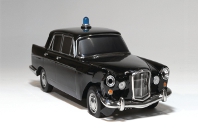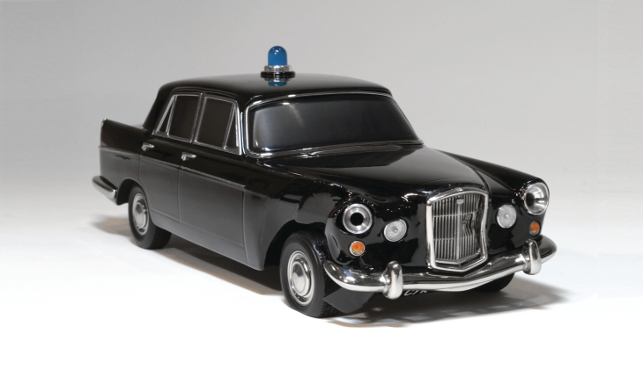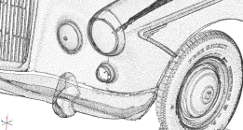In many reverse engineering projects, the end goal is a new part for production or the creation of a prototype for quality control. But now, with the help of Physical Digital, a moment in history has been recreated
In November 2010, the Imperial War Museum opened its newest gallery, ‘Extraordinary Heroes’. The gallery, which is made possible through a £5 million donation from international businessman Lord Ashcroft, is dedicated to the world’s largest collection of Victoria Crosses and tells the stories of the personal bravery and sacrifice behind each medal.

The 1962 Wolseley 6/110 mkII police car complete with crash damage
One of the exhibits within the gallery is a 1:17 scale model of the Wolseley 6/110 mk11. This 1960s police car was driven by George Cross holder PC Tony Gledhill during a car chase across south east London in pursuit of a gang of armed robbers. The police car crashed, and PC Gledhill had to give chase on foot. He finally caught up with, and apprehended the criminals, who included John McVicar – Scotland Yard’s ‘Public Enemy No. 1’ at the time.
Scaling down
London-based creative studio Berry Place was commissioned by the Imperial War Museum to fulfil this task.
In order to reverse engineer the Wolseley, Berry Place had several discussions with Guildford-based 3D scanning and measurement specialist Physical Digital and Performance Engineered Solutions Ltd (PES), then Bromley Performance Engineered Solutions, to look at the feasibility of producing the scale model to budget and within the timescale.
Building an exact replica of the police car, complete with crash damage, was a real challenge for the team at Berry Place. It needed to source exactly the same model of Wolseley in order to produce the car faithfully. Working at a scale of one seventeenth of the original meant that scanning needed to be absolutely precise or details like headlights or chrome trim wouldn’t replicate properly.
Managing Director of Physical Digital, Tim Rapley, explains how Berry Place got its hands on the right car. “The team contacted the Wolseley Owners Club, along with several other auto collectors’ organisations to see if they could find the right model and a willing owner who would let them measure and reverse engineer it.
“They were lucky enough to be put in touch with Conrad Parr of the Cambridge-Oxford Owners Club who had a Wolseley 6/110 mk II and was happy for us to measure it. What’s more, Conrad was an authority on Wolseley in general and so was able to fill us in on period details and answer any questions that the Berry Place guys had in order to ensure that the model was as authentic as possible.”
Challenging 3D measurement
The Wolseley was delivered to Surrey and scanned using GOM’s measuring systems including the ATOS IIe and the TRITOP. The requirement for the model to be faithful to the original meant that it was vital that all the features were correctly captured during scanning. Any data that wasn’t precise enough simply couldn’t be scaled down to the right size for the digital models to be accurate.
What’s more, scanning was particularly complex because the scanners rely on the interaction of light with the measured surface. Not only does the black car absorb the light, its shiny chrome detail reflects it. This presented unique problems to the Physical Digital team.
Setting up the scanning equipment, capturing precise data and transferring that data to the appropriate format took between five and six hours. The scanning process worked at a tolerance of 50 microns per m3, giving PES the very best information from which to reverse engineer the car. Although the vehicle was scanned as a complete model, the data was then broken down into pre-determined sections so that the digital modelling could be done in manageable and accurate segments.
Completing the measurement and digital modelling in this detail was vital because it allowed the Berry Place team to ensure that they could build each part exactly without compromising any of the rest of the vehicle. For example, the data for the hub caps was separated from the data for the wheels. This allowed the hub caps to be chrome plated without the whole wheel needing to go through the same process.
For PES, the reduction in scale made this project particularly challenging. “We used a combination of 3D CAD surfacing and solid modelling techniques with advanced Rapid Surfacing software to manipulate the scan data and complete the final design solution for the project,” explains design director Dan Fleetcroft.
“It was not just a question of giving Berry Place an exact copy of the car; we needed to design and engineer how the model would be assembled and how each component was going to be manufactured. The physical size of each component and desired finish – painted, chromed, transparent etc. – influenced the design and manufacturing techniques that would be employed.”
PES supplied Berry Place with .STL files for each component that needed to be built using Additive Manufacturing technologies and .STP files for those that needed to be machined. The incredible detail on the final files allowed Berry Place to produce an exact replica of the original police car.
On display
Whilst 3D measurement and digital reverse engineering was used to create the scale model of the Wolseley, Berry Place needed to handcraft the crash damage using period photographs from the scene as reference. Once finished, the car was delivered to the Imperial War Museum, where it was seen by PC Gledhill GC who said he was “thrilled” with the accuracy of the replica.
The model can now be seen in the ‘Extraordinary Heroes’ exhibition, which is a free, permanent gallery.
www.berryplace.co.uk / www.physicaldigital.com
www.pes-performance.com
Physical Digital helps recreate a moment in history
No








